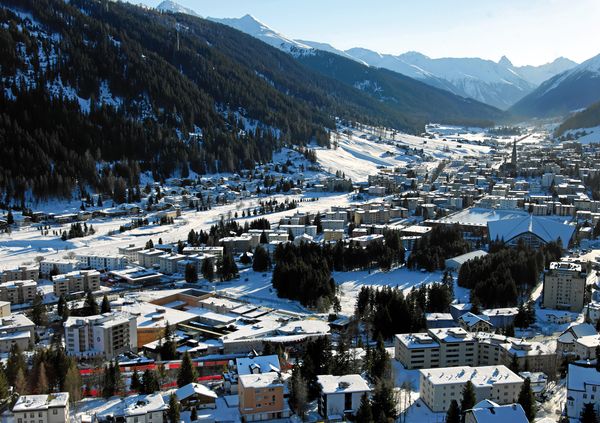Bankers, business leaders and politicians will be flocking to the Swiss town of Davos-Klosters for the World Economic Forum’s Annual Meeting in January to chew over key trends and developments

© World Economic Forum / swiss-image.ch / Photo Andy Mettler
With the ski season well under way, thousands of tourists have been flocking to Switzerland’s world-renowned slopes, which are revered for relaxation and snow play.
The cold season in Switzerland is always a tremendous event, with visitor numbers this year expected to be as high as ever. Winter 2014-15 marks the 150-year anniversary of the advent of cold weather tourism in Switzerland, hailed as one of the world’s top seasonal hotspots. It’s easy to see why tourists choose Switzerland as a place to spend the winter months – the indigo blue lakes, chocolate box villages and magnificent mountain summits make for as adventurous or relaxing a vacation as anyone could hope for.
The Swiss are very proud of their winter tourism industry, even going so far as claiming to have invented winter tourism in the Alps. The roots of winter vacationing in the region are said to originate from the Graubünden region, which was originally visited not for its slopes, but its dazzling pure air and beautiful, sunny winter days. In 1864 Swiss hotel owner Johannes Badrutt bet a group of English summer tourists that they would enjoy a sunnier, more pleasant winter if they vacationed in the Alps. The hotel tycoon promised the group that if they stayed the winter and didn’t enjoy it, he would pay for their visit. Needless to say Mr Badrutt won his bet, and the Alps soon became a bustling hive of winter activity, with downhill skiing arriving a few decades later.
The 150th anniversary of winter vacationing will not be the only thing drawing tourists to the Alps this winter, however, as January will see businessmen and women the world over congregating at the 2015 World Economic Forum (WEF) Annual Meeting in Davos-Klosters. The meeting, colloquially known as ‘Davos’, has been held in the eastern Alps of Switzerland since the birth of the WEF in 1971. This year’s event, which will take place from 21-24 January 2015, is expected to be attended by more than 2,200 delegates and 500 journalists.
Since the very first meeting was held more than four decades ago, the WEF’s commitment to “improving the state of the world” has been reflected in the theme and design of the event, and this year is no exception. The 45th WEF Annual Meeting has the theme ‘the new global context’, which will look at the global climate of change emerging across political, economic, social and technological spheres, and address how these changes could bring an end to the present era of economic integration and international partnership.
‘The new global context’ has come into play in events held by the WEF in the past, including at the 2012 World Economic Forum on Latin America in Puerto Vallarta, Mexico which focused on ‘regional transformation in a new global context’. The meeting took place during a time of great global uncertainty, an era from which we are now gradually emerging, and gave regional and global leaders the opportunity to discuss the challenges facing Latin America in planning for a sustainable future, economic recovery and regional transformation.
So what can we expect for attendees of this winter’s most anticipated event?
This year’s annual meeting will serve as a platform for leaders to develop the necessary insights, ideas and partnerships to respond to the aforementioned ‘new global context’, and pave the way for future decision-making. Dialogues taking place throughout the event will map the key transformations facing the world in 2015. The meeting will play host to more than 250 talks and assemblies researched and designed in collaboration with the WEF’s Global Agenda Councils.
This winter’s event will be attended by a multitude of regional and international representatives, with delegates expected to include the CEOs of 1,000 of the world’s largest businesses, national leaders and heads of top international organisations.
WEF members’ attention was focused on economics closer to home in October when organisations belonging to the WEF’s strategic partnership were notified of a 20 per cent hike in their annual meeting membership – the first increase since the partnerships were formed in 2005. Strategic partnership is the highest level of WEF membership and allows subscribers to send five people to the Annual Meeting in Davos, as well as facilitating the participation of delegates at other regional meetings, including the annual WEF meeting in China. In a letter sent out to subscribers of the partnerships, the WEF stated that the annual fees would be raised from SFr500,000 (US$523,000) to a whopping SFr600,000 from July 2015.
Despite partnerships allowing for attendance at other events, it is likely that some partners will see the increase as an added cost for Davos attendance, which, when allowing for accommodation and transport, already racks up quite a bill.
However, with the increase not due to come in until later in the year, it’s as likely as ever that all the big faces of global politics and business will be found in Davos this January. Skiers will once again have to make room for thousands of extra visitors as statesmen and women the world over descend upon the slopes for a lively four-night spell in Davos.





